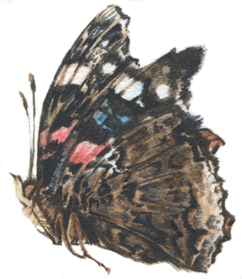April 1st, 2014
In my blog from a week ago I spoke about making a print in a new material: SoftCut.
Making a print, doesn’t matter if it’s an etching, drypoint or linocut, is always a difficult
thing for me because I hurt my hand in 2008. Things got overworked, inflamed, my thumb
hurt like crazy and for about a year I couldn’t do anything. Writing, drawing, even holding a book
during reading was a challenge.
Over time things got better but my hand is still not the way it used to be. I can’t work long
hours, I had to stop all printing activities and I switched from pencil and pastels to drawing inks.
Progress is still made, the amount of time I can work increases. Recently I started a drawing in
pencil, something I couldn’t do for a long time. Still I have to be very careful not to overdo it.
So making a linocut was a big challenge.
This is why I set out to look for a material that would give the impression of a linocut but
would be more easy to cut. I made some stamps out of big erasers but with erasers size
is limited. At Hoopman Artsuplies I found SoftCut.
It has pros but also quite a few cons, especially when you are used to linoleum. SoftCut is a
flexible sheet of rubber. It has one smooth and one less smooth side. The smooth side is the
side to cut. It doesn’t have a woven structure like linoleum, it’s just rubber.
SoftCut is available in different sizes varying from 75x75 mm to 200x300 mm.
Pros:
- For me and my problematic hand SoftCut was great. My tools would just cut through the
surface (almost) like butter.
- If you want to cut a round shape you don’t have to stop or be extra careful not to mess up
your work. You can easily take the corner by twisting your hand/ tool or by twisting SoftCut
into the right direction.
- It doesn’t break like linoleum does so it’s very suitable for detailed work.
- Flexibility makes it possible to make prints on curved surfaces.
Cons:
- The biggest size SoftCut available is 200x300 mm. Much smaller than linoleum. The print
Jantine and I did was actually made by printing 2 sheets of SoftCut next to each other so the
size would be 200x600 mm. This was because of SoftCuts flexibility not an easy task.
- When you cut linoleum the last bit of the snippet kinda breaks off, you don’t have to
finish the cut. SoftCut doesn’t do that, you have to remove the snippets by pulling them off
which takes time.
- To trace our design on the SoftCut Jantine and I first tried to use carbonpaper but that would
not take! Pencil did take and ballpoint did too but both would easily smudge or disappear
altogether.
- Flexibility was also a con because during the whole printing process the shape of the SoftCut
sheet would not remain the same. We had to take off all pressure of the press so it would not
smudge, or compromise SoftCuts shape. So better to use a baren instead of a press.
For me SoftCut is a great new material which allows me to finally continue my printing career
but I think most artists who don’t have similar problems like mine will stick with linoleum.
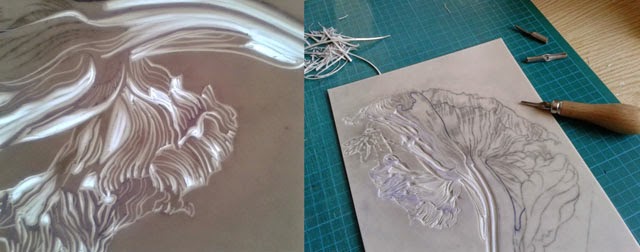
- Gegevens
- Hits: 9373
March 27th, 2014
A month ago I posted a blog about art related books I was reading. I want to continue that
tem but then I realized something. Next to ‘normal’ books with just letters and the
occasional illustrative picture I also read comic books or, as the French would say, la bande
dessinée. ‘Comic books?’ you might wonder. Don’t worry, I’m still on topic. Because did you
now there are a lot of these about artists?
Artists like Rembrandt van Rijn, Vincent van Gogh, Egon Schiele and much more! The
picture below shows just the ones that I have, there are lots and lots more! So here’s a fun
idea. I will read these (again) and try to get my hands on the others I know of and let you
know what they are like.
And my next blog will truly be about SoftCut.
On the pic below starting with title, then artist and publisher. Note that these are all Dutch
versions:
Pablo 1, 2, Julie Birmant & Clément Oubrerie, Blloan.
Egon Schiele, Xavier Coste, Casterman.
Typex’ Rembrandt, Typex, Oog & Blik//Bezige Bij.
Vincent & Van Gogh, Gradimir Smudja, Silvester.
Gauguin, Gaultier & Le Roy, Le Lombard.
Munch, Steffen Kverneland, Oog & Blik//Bezige Bij.
Het Kunstbordeel (Henri de Toulouse-Loutrec) 1, 2, 3, 4, Gradimir Smudja, Silvester.
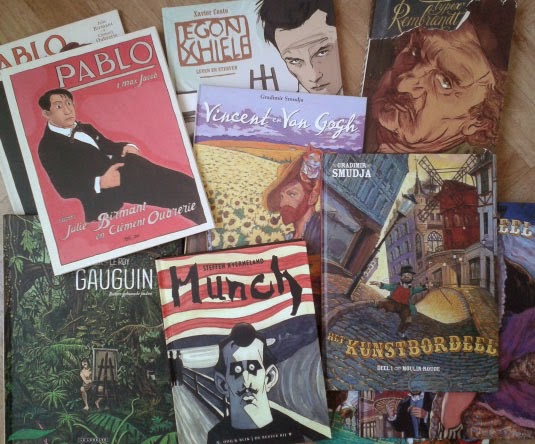
- Gegevens
- Hits: 4802
March 24th, 2014
Finally after a whole month of silence I can show you what I’ve been doing. Between my
part-time job and the ‘secret project’ in my studio there wasn’t much time left to do
anything else and sorry to say no time for writing substantial blogs. But the silence ends here.
What have I been doing that was so secret?! Well, it might be a little less exciting than it sounds.
I belong to a group of 7 artists that share a studio at Grafisch Collectief Thoets. Our group
is specialized in printing techniques like etching, woodprint, lithograph and silkscreen.
We present ourselves as a group and once a year have an open studio day. We also have a
group of people who donate money so we can continue to exist, organise fun art projects etc.
For these nice, giving people we make a print that’s not for sale, just a special gift to them.
This year Jantine Geels and I were the ones to make the print. We usually do this in a team of
two which results in very surprising prints, very much to the liking of our donators.
The upper part is mine aside from the bee. The stem turning into the umbilical cord ending in
a flower that is also the embryo's belly are mine too. The bee and lower panel showing the
embryo were done by Jantine Geels.
The print resides in a handprinted booklet about Make A Move, a project we contributed to in
October 2013.
It’s been a month of organizing, designing, sketching, (lino-)cutting, printing and folding
(yes, folding!). The print was presented Sunday the 16th and was received positively and I'm
pretty pleased with it also.
The print was done in a material called SoftCut, something I will talk about in my next blog.
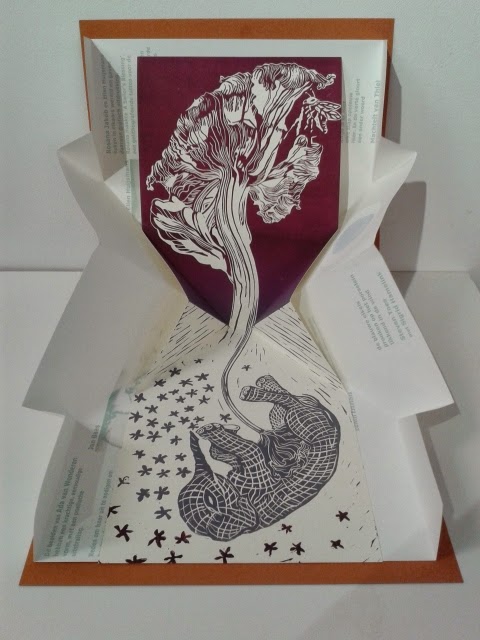
- Gegevens
- Hits: 5159
February 24th, 2014
I like books. I like everything about them. I like to read them, flip through them, smell them
and own them. So when I need some information about something I'm still more
likely to look for the answer in a book rather than the internet.
When I re-started this blog I actually did both but I want to share the books I read.
First I started in 'Blog INC' by Joy Deangdeelert Cho (Chronicle Books). A very helpful book
about how to start a blog and make it successful. What I really liked was the fact she
nterviewed lots of good bloggers and you get a nice view on how they started and what it
took to be where they are now.
After that I read 'Blogging For Creatives' by Robin Houghton (HOW Books). The title
appealed to me but it also had lots of new things to offer alongside 'Blog INC'.
'Blogging For Creatives' gives a bit more technical information. It compares different
blogging platforms and it has nice colour pictures that give you inspiration and an idea
about possibilities for your own blog. Both books have good tips about questions one
might have like for instance: "how often should I post?"
So if you want to read more about how to blog I recommend both books.
Right now I'm reading 'How to be an Illustrator' by Darrel Rees (Laurence King). First edition
was 6 years ago and this second edition is nicely updated. Both on information and
beautiful colour illustrations. It's focused on the starting illustrator freshly out of (or still in)
college but that's no problem. Lot's of interviews with both illustrators and others that
are working in the industry. Helpful tips about making a portfolio, job-hunting, financial tips,
promoting yourself etc.
The book is from the UK but includes information about the US and so on.
All books were purchased at ABC - The American Bookcenter (Amsterdam).
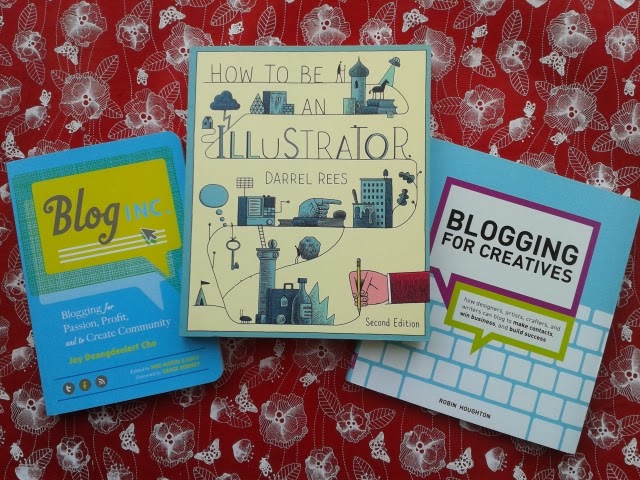
- Gegevens
- Hits: 5266
February 12th, 2014
On January 29th I posted a blog about sketchbooks. Book By Its Cover has this
wonderful page where you can have a look into artist’s sketchbooks. Very inspiring.
Nonetheless filling those sketchbooks myself keeps being a challenge.
The blank page remains an obstacle. The content of the page still should be “perfect”
or at least good enough for others to see. Why can’t I just let go of that?
A sketchbook should be a little private place where an artist should feel total freedom
to do whatever they feel like.
Why can’t I just splatter my ink all over the pages, scribble relentlessly on top of the mess?
Why can’t I just experiment BIG?! I can’t think of any other reason but fear. Fear of making
ugly things, fear of losing control, fear of being found out? How will I ever know what I’m
capable of when I keep being scared? I won’t, it’s as simple as that and I had enough.
First step to overcome fear is to show you a page from my current sketchbook that I would
never show without being embarrassed. It was done after a dream I had. I used ink, pencil
and felt-tips.
I was not happy with the result and I stopped working like this right when I started.
Melissa, start experimenting, start making a mess!!
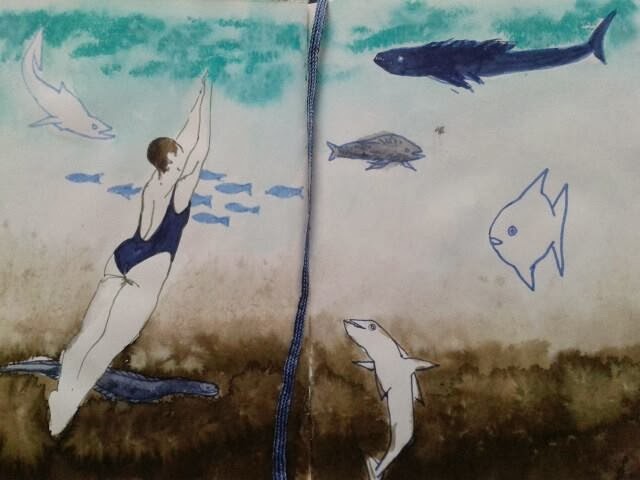
- Gegevens
- Hits: 8507
Pagina 41 van 44
